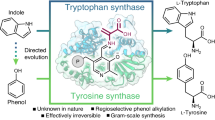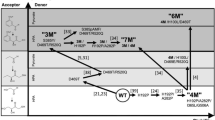Abstract
A single point mutation has been engineered in the tyrosyl-tRNA synthetase that improves its affinity (KM) for its substrate ATP by a factor of 100. In the crystal structure of the tyrosyl tRNA synthetase (of Bacillus stearothermophilus), the side-chain hydroxyl of Thr 51 appears to make a weak hydrogen bond with the AMP moiety of the substrate intermediate, tyrosyl adenylate. In the absence of substrate, however, the hydroxyl group should make a strong hydrogen bond with water which would favour dissociation of the enzyme–substrate complex. We have used oligodeoxynucleotide-directed mutagenesis to construct two point mutants at this site: one to remove the hydroxyl group (Thr 51 → Ala 51) and the other, in addition, to distort the local polypeptide backbone (Thr 51 → Pro 51). We report here that both mutants have increased activity (kcat/KM for ATP) but one mutant (Pro 51) shows a massive 25-fold increase due mainly to a lowered KM for ATP. This demonstrates dramatically the potential of in vitro mutagenesis for improving the affinity of an enzyme for its substrate.
This is a preview of subscription content, access via your institution
Access options
Subscribe to this journal
Receive 51 print issues and online access
$199.00 per year
only $3.90 per issue
Buy this article
- Purchase on SpringerLink
- Instant access to full article PDF
Prices may be subject to local taxes which are calculated during checkout
Similar content being viewed by others
References
Hall, A. & Knowles, J. R. Nature 264, 803–804 (1976).
Hall, B. G. Genetics 89, 453–465 (1978).
Hall, B. G. & Zuzel, T. Proc. natn. Acad. Sci. U.S.A. 77, 3529–3533 (1980).
Paterson, A. & Clarke, P. H. J. gen. Microbiol. 114 75–85 (1979).
Turberville, C. & Clarke, P. H. FEMS Microbiol. Lett. 10, 87–90 (1981).
Wu, T. T., Lin, E. C. C. & Tanaka, S. J. Bact. 96, 447–456 (1968).
Winter, G., Fersht, A. R., Wilkinson, A. J., Zoller, M. & Smith, M. Nature 299, 756–758 (1982).
Wilkinson, A. J., Fersht, A. R., Blow, D. M. & Winter, G. Biochemistry 22, 3581–3586 (1983).
Monteilhet, C. & Blow, D. M. J. molec. Biol. 122, 407–417 (1978).
Rubin, J. & Blow, D. M. J. Molec. Biol. 145, 489–500 (1981).
Bhat, T. N., Blow, D. M., Brick, P. & Nyborg, J. J. molec. Biol. 158, 699–709 (1982).
Zoller, M. & Smith, M. Nucleic Acids Res. 10, 6487–6500 (1982).
Sanger, F., Nicklen, S. & Coulson, A. R. Proc. natn. Acad. Sci. U.S.A. 74, 5463–5467 (1977).
Biggin, M. D., Gibson, T. J. & Hong, G. F. Proc. natn. Acad. Sci. U.S.A. 80, 3963–3965 (1983).
Winter, G., Koch, G. L. E., Hartley, B. S. & Barker, D. G., Eur. J. Biochem. 132, 383–387 (1983).
Gait, M. J., Matthes, H. W. D., Singh, M., Sproat, B. S. & Titmas, R. C. Nucleic Acids Res. 10, 6243–6254 (1982).
Winter, G. & Fields, S. Nucleic Acids Res. 8, 1965–1974 (1980).
Author information
Authors and Affiliations
Rights and permissions
About this article
Cite this article
Wilkinson, A., Fersht, A., Blow, D. et al. A large increase in enzyme–substrate affinity by protein engineering. Nature 307, 187–188 (1984). https://doi.org/10.1038/307187a0
Received:
Accepted:
Issue date:
DOI: https://doi.org/10.1038/307187a0
This article is cited by
-
Specific affinity and relative abundance of methanogens in acclimated anaerobic sludge treating low-strength wastewater
Applied Microbiology and Biotechnology (2020)
-
5-Fluorouracil Co-crystals and Their Potential Anti-cancer Activities Calculated by Molecular Docking Studies
Journal of Chemical Crystallography (2016)
-
Protein engineering 20 years on
Nature Reviews Molecular Cell Biology (2002)
-
Biocatalysis made to order
Applied Biochemistry and Biotechnology (1988)



